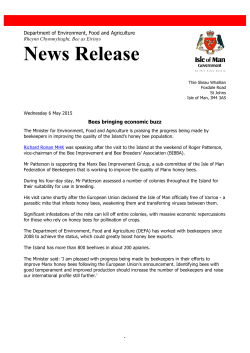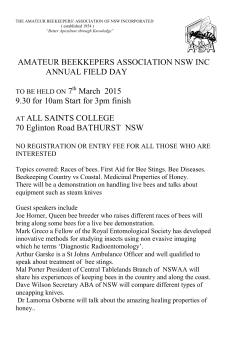
Gifts from the Maya honeybee god
Gifts from the Maya honeybee god By Franclyn Heinecke, Puyallup, Washington Map of Quintana Roo in the Yucatan. A statue of the Maya honeybee god, Ah Muzen Kaab, welcomes drivers to Playa del Carmen. Beekeepers visiting Quintana Roo can see a lot more than Cancun’s hotel row and Playa del Carmen’s 5th Avenue stores featuring all things Mexico. The eco-park Xcaret1 has a bee display that shows several melipona beecheii bee species native to the Yucatan peninsula, and how hollowed logs are used for traditional hives. The ancient Maya ruins of Tulum and Coba (Nat’l Inst. 2007) show carvings of the descending god who the Maya call An Muzen Kaab, the god of the honeybee. As a gift from the gods, the Maya believe that Xunan Kaab, the honeybee, should be handled with reverence and care (Hursch 2009, Villanueva-G 2005). Maya carvings on log hives at Xcaret, with a tiny melipona bee guarding the nest entrance. 1 “X” in Maya is pronounced as the English ”sh.” Xcaret is pronounced “Esh-caret.” 1 A carving of the descending god at Tulum. Hearty people climbing Nohoch Mul, Coba’s “big pyramid: with its top temple to the honeybee god. At Coba, tour guides may point out a kaab (bee) nest in a tree where the jungle meets the road on the way to the big pyramid. The dime-sized hive entrance is easy to miss, as is the diminutive melipona beecheii guarding the entrance. Watch closely and you may see the tiny bees returning to the hive with an almost invisible amount of pollen. This species of bee is so small that 10 to 15 of them could fit on an average adult thumbnail. The dime-sized melipona nest entrance is easy to miss on this tree in Coba’s jungle. Close-up view shows the nest entrance and size of bees in relation to an adult fingernail. 2 Tiny as it is, and facing similar threats as the U.S. honeybee, apis mellifera, the melipona bee has, nonetheless, survived and so has its human caretaker, the traditional Maya beekeeper. Bees, beekeeping and honey were important to the ancient Maya (Hursch 2009, Cortopassi-Laurino 2006). In Tulum, honey was one of the most important products exported throughout Mesoamerica. The Spanish who arrived in the Yucatan in 1517 found bee yards with thousands of hives, making honey of great importance to the culture and economy of the ancient Maya (Hursch, 2009). Looking at the beekeeper pages of the Madrid Codex one can see the resemblance between stylized bees found there and carvings of the descending god at Tulum and Coba. Bees and bee glyphs dominate many of the Codex pages, with one plate showing what looks to be a major god honoring the honeybee (FAMSI). Plate from the Madrid Codex of Maya writings. Honeybee motif shows on many Madrid Codex pages. Beekeeping continues to be one of the most important money-making activities for Maya families today (Love 2004), closely linked with their spiritual way of life (Hursch 2009, Cortopassi-Laurino 2006). The Maya are resilient, proud people who have survived “500 years of economic deprivation, political persecution and genocide” (National Geopraphic 2008). They continue to lead agriculture-based lives, but expanding tourism and economic difficulties are challenging that way of life. Inviting eco-tourism to the villages 3 may be one way to maintain their lifestyle while educating others about the unique Maya culture and life perspective. It was just such an eco-tour that led to a chance meeting with Don Crisanto Kahun Uc, a Maya shaman who has been keeping bees for 54 years. He lives in the village of Tres Reyes, not far from the ruins of Coba. A few days later, a second tour included the honor of visiting Don Crisanto’s home, meeting his family, participating in the ritual bee ceremony, U-Hanil-Kaab (Villanueava et al 2005) and learning about age-old beekeeping traditions among the Maya of the Yucatan peninsula. Incense from a tree resin wafts through the air as Don Crisanto prays and prepares the ceremonial site. Stakes are carefully placed at the four compass points that represent different aspects of the sun. From each stake, vines are entwined and hung to cradle a woven disc that supports a bowl of posole, honey and pollen that Don Crisanto has carefully prepared. The bowls of posole are offerings to the gods, invited through prayer to join the ceremony. We three tourists and our translator are asked to stand, one at each compass point, and are smoked with incense and sprinkled with water to cleanse and prepare us for the gifts to come. Don Crisanto chants and prays, invoking gods to bless the gathering and to protect both bees and people from harm that the other could cause2. After blessing participants, Don Crisanto smokes and blesses his hives. 2 Careless opening of hives sometimes kills bees and certainly disrupts the colony. While Melipona are stingless bees, they do bite. Their bite deposits sticky resins and even a type of formic acid, and they usually aim for the eyes, ears or mouth of an unwelcome hive intruder. 4 Following the Maya tradition, at his home Don Crisanto uses hollow logs for his hives. He has two melipona species here – one larger variety and the tiny bee seen earlier at Coba. To open the hives, he must first chip loose the mud that seals the corkshaped end piece. Rather like chipping away propolis, it’s slow and steady work that can take some time. He points out a honey “pot” made of cerumen – a mixture of bees wax and plant resin (Roubik 2006). Melipona bees deposit nectar in pot chambers and, when the nectar is cured, it is closed with more cerumen. Don Crisanto gingerly removes the pot, opens a honey chamber and treats us to a taste of his bees’ fine work. Melipona honey has 30 percent water (Vit et al 2004) and, therefore, ferments after a few months. Because of that, it must be used more quickly than mellifera honey, with 18.6 or less percent of water. Maya beekeepers harvest up to five or six times a year, selling their honey to farmer cooperatives, at local markets, or along village streets. Such harvesting provides fairly regular and needed cash income at frequent intervals (Love 2004). 5 In his other hive are the tiny melipona species. Upon opening the hive, he points out the batumen – a resin layer that may also include mud, seeds, wood and feces of vertebrates used to seal the inner hive chamber from the outside environment (Roubik 2006). The batumen can be up to 10 cm thick, rock hard and difficult to open. Don Crisanto chips through the batumen and exposes the inner hive. In Maya he exclaims, “Oh, the babies are coming out!” With 38 cells in a brood area the size of a quarter, it’s difficult to see the tiny “babies”– tiny melipona bees are emerging from their cells. With such a tightly structured nest, what about hive ventilation? Roubik (2006) explains that the melipona use a “tidal exchange” of gases that helps the hive “breathe.” With controlled nest entrance fanning, worker bees are able completely exchange the nest air in one to seven hours. Melipona bees carry water out of the hive. Latrines are maintained inside the nest, where mutualist organisms consume adult bee defecations (Roubik 2006). Don Crisanto notes other differences between the melipona and the mellifera bees: • Melipona queens mate only once. • Drones are able to collect food from flower sources. • Colonies must build new nest sites before swarming. • Nurse bees do not feed young. Rather, enough pollen and nectar is stored in each cell for bee development. Also worth noting are some of the challenges to traditional Maya melipona beekeeping (Cortopassi-Laurina et al 2006, Villanueva-G, Rogel et al 2005): • A shift in worldwide production has hurt Mexico’s honey economy. Until 30 years ago, the three states on the Yucatan peninsula (Quintana Roo, Yucatan and Campeche) led the world in honey exports. Now, China and Argentina lead. • Increased development with a related decrease in natural bee foraging areas. • Resource competition from mellifera bees makes it harder for melipona bees to find food. 6 • • • • Melipona honey, with its higher water content, is becoming more difficult for traditional beekeepers to sell; the mellifera honey has a longer shelf life. Increased use of pesticides and herbicides that compromise bee health. Difficult economic conditions that cause many Maya to leave villages to find work in tourist cities. The need to educate traditional beekeepers about such strategies as supplemental feeding, controlled honey harvest, and hive splitting. At least in Tres Reyes, Don Crisanto reports that his bees are doing well. The logs are ready for hive splitting. Hopefully, next year he will get a good harvest of honey that, he says, is even better as medicine than as a sweetener (Vit, et al 2004). Before leaving his hives, Don Crisanto reverently rubs the inside of the logs with leaves to cover his human scent, and carefully recorks the logs. We all return to the ceremonial alter to partake of the posole, thanking each other and the bees for a memorable day in the Yucatan when we received gifts of knowledge and understanding from the royal lady – Xunan Kaab, the melipona honeybee. Maya bee ceremony participants drinking the posole beverage (from left) Shaman Don Crisanto, his children Ana (age 5) and Rodrigo (3), translator Juan Carlos Montano Gonzales, author Franclyn Heinecke and her sisters Roxanne Neveau and Robyn Medeck. Special thanks: * Muchas gracias, Juan Carlos Montano Gonzalez, for working so hard to make this tour happen and for providing such thoughtful translation. * Hach yum booltic, Don Crisanto for your serene, gentle teaching ways and for opening your hives to us. * Hach yum booltic, melipona kaab. 7 References: Coe, Michael and Mark Van Stone, 2001. Reading the Maya Glyphs; Thames and Hudson, Ltd., London Cortopassi-Laurino, Marilda et al., 2006. Global meliponiculture: challenges and opportunities; Apidologie 37, 275-292. FAMSI – Foundation for the Advancement of Mesoamerica Studies, Inc.; Maya Hieroglyphic Writing: The Ancient Maya Codices, the Madrid Codex pdf. FAMSI.org/mayawriting/codices/Madrid; downloaded Oct 2, 2009. Hursh Graber, Karen, 2009. Honey: a sweet Maya legacy. Mexconnect.com/articles/3286-honey-a-sweet-legacy; downloaded Oct 3, 2009. Love, Bruce, Ph. D., 2004. Maya Culture of the Yucatan Today. Editorial Dante S.A. de C.V., Merida, Yucatan, Mexico. National Geographic Society, 2008. Chris Johns, Editor. Mysteries of the Maya. National Geographic Society, 1989. Wilbur Garrett, Editor. La Ruta Maya, Vol. 176. No. 4, pages 424-505. National Institute of Archaeology and History, 2007. Coba – History, Art and Monuments. Monclem Ediciones, Mexico S.A. de C.V. Roubik, David W., 2006. Stingless bee nesting biology, Apidologie 37, 124-143. Villanueva-G, Rogel, David Roubik and Wilberto Calli-Ucan, 2005. Extinction of melipona beecheii and traditional beekeeping in the Yucatan Peninsula. Bee World 86, 35-41. Vit, Patricia, Margarita Medina and Maria Eunice Enriquez 2004, Wuality standards for medicinal uses of Meliponinae honey in Guatemala, Mexica and Venezuela, Bee World 85, 2-5. 8
© Copyright 2025









